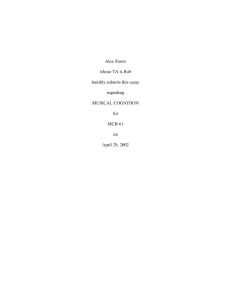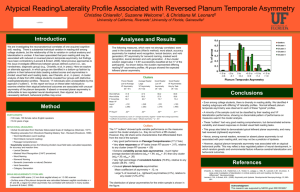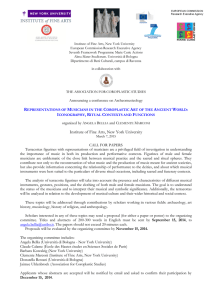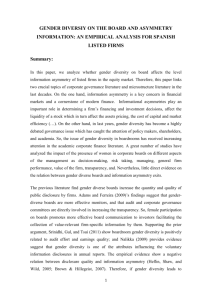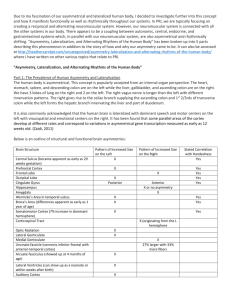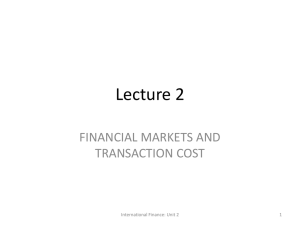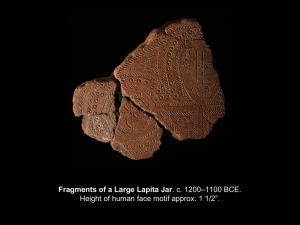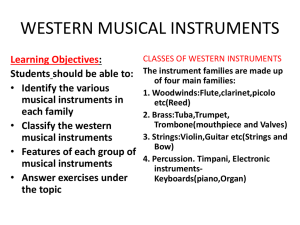Evolution of the brain and cognition
advertisement
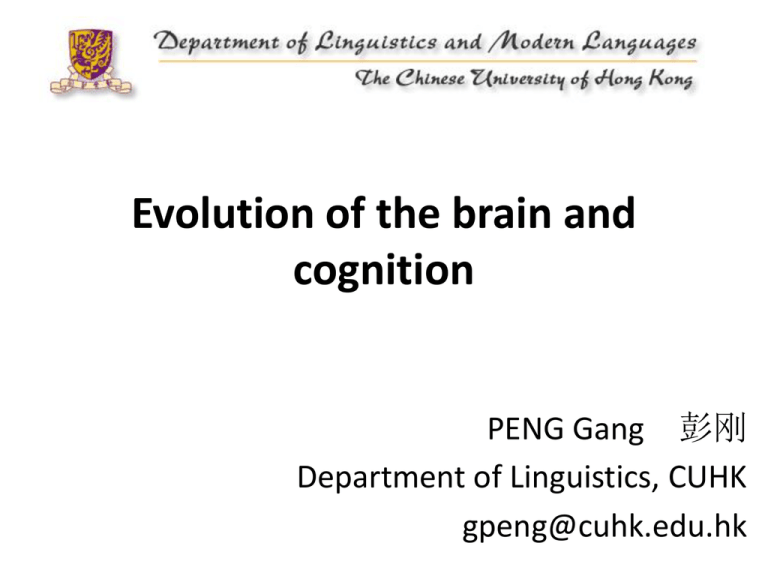
Evolution of the brain and cognition PENG Gang 彭刚 Department of Linguistics, CUHK gpeng@cuhk.edu.hk • “Language as Shaped by the Brain” By Morten Christiansen • “Broca’s Area and the Evolution of Language” by Tom Schoenemann • … • Part 1: Evolution of the human brain and cognition • Part 2: Brain, experience, and behavior Sapir-Whorf Hypothesis updated (Adapted from Prof. Wang’s speech) BEHAVIOR LANGUAGE EXPERIENCE BRAIN Different LANGUAGES EXPERIENCES shape different BRAINS; different brains produce different perceptions; different perceptions produce different BEHAVIORS. 4 It is the cortical area just posterior to the auditory cortex within the Sylvian fissure. It is a triangular region which forms the heart of Wernicke’s area. Brain asymmetry in adults • Geschwind and Levitky found that the planum temporale is larger on the left in 65% of brains; on the right is only 11%. (100 adult human brains, obtained at postmorten, and free of significant pathology) Geschwind, N., and Levitsky, M. (1968). Human brain: Left-right asymmetries in temporal speech region. Science 161: 186-187. Brain asymmetry in newborns 16 were adults and 14 were infants (which included 11 neonates) whose postnatal ages were 1,1,1, 2,2, 6,11,13,19 and 21 days and 1, 2, 3 and 3 months with a median age of 12 days. Witelson, S. F., and Pallie, W. (1973). Left hemisphere specialization for language in the newborn: Neuroanatomical evidence of asymmetry. Brain 96: 641-646. Musical ability and brain asymmetry • Schlaug et al found that musicians with absolute/perfect pitch revealed stronger leftward planum temporale asymmetry than nonmusicians or musicians with out perfect pitch. Schlaug, Gottfried, Jaencke, L., Huang, Y. and Steinmetz, H. (1995). In vivo evidence of structural brain asymmetry in musicians. Science 267:699–701. Genetic advantage for East-Asia people • Extremely rare in the U.S. and Europe, with an estimated prevalence in the general population of less than one in 10 000. • Onset of musical training has been consistently found to be an important factor for AP. Profita, Joseph and T.G. Bidder. (1988). Perfect pitch. American journal of medical genetics, 29:763–771. Deutsch, Diana, Henthorn, T., Marvin, E. and Xu, H.-S. (2006). Absolute pitch among American and Chinese conservatory students: Prevalence differences, and evidence for a speech-related critical period. Journal of Acoustical Society of America 119:719–722. Peng, Gang, Deutsch, Diana, Henthorn, Trevor, Su, Danjie, and Wang, William S-Y. (2013). Language experience influences non-linguistic pitch perception. Journal of Chinese Linguistics. Percentage correct Tone 60 Nontone Chance 40 20 0 2--5 6--9 ≥10 Age of onset of musical training Percentage correct responses on the test of AP, as a function of age of onset of musical training for two language groups. Peng, Gang, Deutsch, Diana, Henthorn, Trevor, Su, Danjie, and Wang, William S-Y. (2013). Language experience influences non-linguistic pitch perception. Journal of Chinese Linguistics. Genetic advantage to East Asian people? Percentage correct responses on the test of AP, as a function of age of onset of musical training and fluency in speaking a tone language. Those in groups tone very fluent, tone fairly fluent, and tone non- fluent were all of East Asian ethnic heritage. Those in group nontone were Caucasian and spoke only nontone language. Deutsch, Diana, K. Dooley, T. Henthorn and B. Head. (2009). Absolute pitch among students in an American music conservatory: Association with tone language fluency. Journal of Acoustical Society of America, 125:2398–2403. • The answer to the above question is “NO”. • In Schlaug et al’s study, musicians with AP revealed stronger leftward planum temporale asymmetry. How did such a stronger asymmetry come from? Postnatal musical training is probably the important driving force! Schlaug, Gottfried, Jaencke, L., Huang, Y. and Steinmetz, H. (1995). In vivo evidence of structural brain asymmetry in musicians. Science 267:699–701. Amazing brain plasticity Four visibly but not lexically distinguishable colors, were taught to subjects to exemplify, respectively, four new lexical categories, named with meaningless Mandarin monosyllables. Kwok, V., Niu, Z., Kay, P., Zhou K., Mo, L., Jin, Z., So, K.F. & Tan, L.H. (2011). Learning new color names produces rapid increase in gray matter in the intact adult human cortex. Proc Natl Acad Sci USA, 108(16): 6686-8 Amazing brain plasticity Differences in gray matter volume between post- and pretraining scans, as illustrated by images from axial (Left), sagittal (Center), and coronal (Right) views. The region in the cerebral cortex surviving a whole-brain– based analysis (P < 0.005 uncorrected) is V2/3 (X = −10, Y = −77, Z = 3; Z=3.58).One area in the cerebellum(X=13,Y=−75,Z=−38;P<0.005 uncorrected; Z = 3.86) also shows a volumetric difference. A small volume correction (20-mm) analysis of V2/3 indicated that the difference was significant at P < 0.05 FWE. Is it a transient effect? • Don’t know yet. • It’s probable that long-term intensive postnatal training influences brain structure. • The stronger leftward planum temporale asymmetry for musicians may be partially due to the training effect. Sapir-Whorf Hypothesis updated (Adapted from Prof. Wang’s speech) BEHAVIOR LANGUAGE EXPERIENCE BRAIN Different LANGUAGES EXPERIENCES shape different BRAINS; different brains produce different perceptions; different perceptions produce different BEHAVIORS. 16 "Does use and exertion of mental power gradually change the material structure of the brain, just as we see, for example, that much used muscles become stronger? It is not improbable, although the scalpel cannot easily demonstrate this.” Samuel Thomas Soemmering, 1791. Quoted in Restak, R. (2003). The New Brain: How the Modern Age is Rewiring your Brain. London, Rodale` Kay, P., & Kempton, W. (1984). What is the Sapir-Whorf hypothesis? American Anthropologist, 17 86, 65–79. Thank you! 谢谢!
